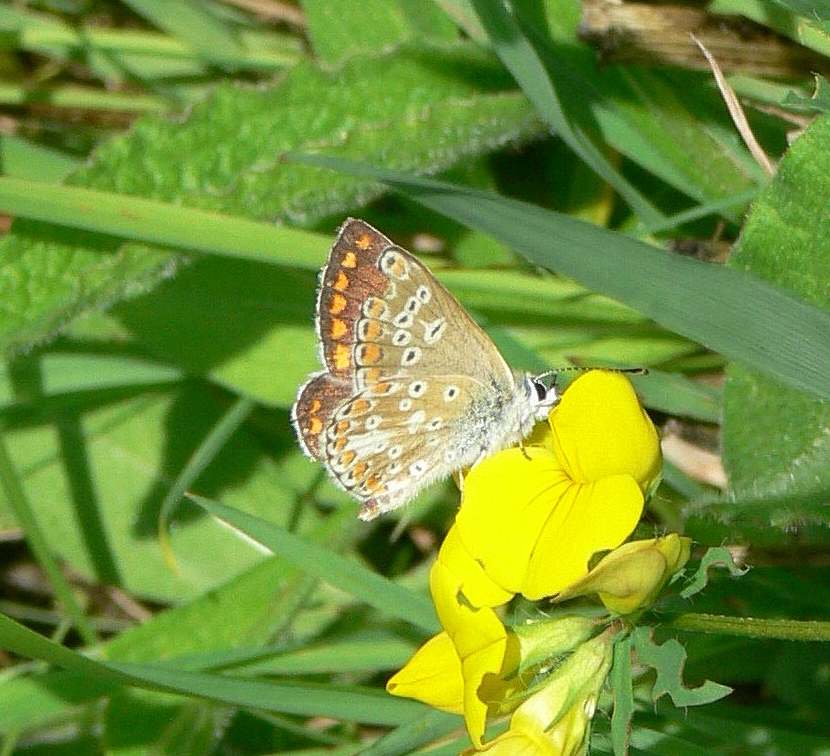A perculiar Small Tortoiseshell found just outside of the wood.

Wildlife In Ox Close Wood
A perculiar Small Tortoiseshell found just outside of the wood.

The Brown Argus Aricia agestis is another new butterfly that Trust members have found in Ox Close Wood and in fields in East Keswick. This is great news – showing that the management of our reserves is being rewarded with these successes (see Silver-washed Fritillary, below). The caterpillers’ foodplant is usually Common Rock Rose but more recently they have started to use various geraniums, including Meadow Cranesbill, of which there is plenty in the parish.


A New Butterfly… Silver-washed Fritillary

A Silver-washed Fritillary butterfly has been seen for the first time in Ox Close. A male (characterised by the bands along the forewings) was seen on at least three occasions. Its foodplant is Violet of which there are plenty in the wood – so with a bit of luck…. it could breed!
I was able to photograph a Hornet in Ox Close this afternoon.
This is the first I’ve seen in the wood and it confirms its presence which has been suspected for a couple of years now.


For the first time since the 18th century, cows are grazing in Ox Close Wood!
The cows will graze the paddock for a few weeks after which they will go to another reserve to continue their conservation grazing.
Once part of the Common lands of EastKeswick, Ox Close was a wood pasture where wood and timber could be cut and extracted during the winter months and animals grazed during the summer by the Commoners of the village – usually the most prominent residents. By the end of the 18th century, the management of Common lands was deemed inefficient so increasing numbers of individual parish Parliamentary Enclosure Acts were passed to provide the legal framework for privatisation. All Commoners rights to graze in Ox Close ceased at the beginning of 19th century on the enclosure of East Keswick when the wood became part of the Harewood Estate.
The photos show three cows, each with a calf being let into the wood. Because Clarita (below) has horns, she had to be transported separated from her calf and separately from the other cows.


Even though Autumn is approaching quickly, there’s still plenty to see in the wood. Of the birds, there are quite a few Buzzards and, along the river, Kingfishers. Nuthatches have done well this year.
There are still two or three species of butterfly, particularly the Speckled Wood, and the Red Admirals are looking very smart in their newly-emerged condition.


Similarly for Odonata. Brown Hawkers and still present and there were four or five Southern Hawkers. I didn’t see any Darters today, but they will be around still.


During the last 12 months Ash Dieback has become very noticeable. Younger trees are more susceptible than mature trees although we have yet to see the full impact of this fungal disease. Dutch Elm Disease has been present for many years: Many of the Elms in the wood are reaching the age (20 to 25 years) when the Elm Bark Beetle can lay its eggs under the tree’s bark but our (EKWT) regular coppicing of living trees extends their life, ensuring a reliable food source for the White-letter Hairstreak butterflies.


Last Friday the workparty cut and raked an area at the lower end of the grazing pasture to give next year’s Bluebells a clear area in which to flower.

So Summer is here!
SUCCESS AT LAST. Brimstone butterflies are breeding.
7th-9th May 2010. Brimstone butterflies were seen egg laying on the Alder Buckthorn. This is fantastic news. Back in January 2003, fifty Alder Buckthorn saplings were planted along the top ride in the hope of attracting Brimstone butterflies. Over the years since then, only the occasional insect has been seen. But this weekend at least three pairs were seen – with the females egg laying. It is likely that these insects are the offspring of some that bred unseen last year. See the photo in the Butterflies gallery.